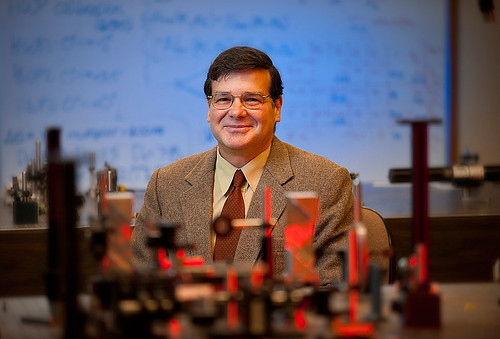When professor Enrique “Kiko” Galvez delves into his scholarly work as a quantum physicist, it is not unusual for him to choose ¸Ô±ľĘÓƵ undergraduates — some still in their first year — as his research partners.
“They work alongside me on significant research projects, which is not always typical for students at schools the size of ¸Ô±ľĘÓƵ,” said Galvez. “My students’ research helps them significantly in their future careers.”
In fact, in the 21 years that Galvez has been at the university, more than 40 ¸Ô±ľĘÓƵ students have been listed as co-authors on physics research projects and 70 have participated in conference presentations.
Now, his commitment to faculty-student research is being recognized by the American Physics Society (APS).
 |
| ¸Ô±ľĘÓƵ professor Enrique “Kiko” Galvez’s commitment to faculty-student research was recognized by the American Physics Society. (Photo by Andy Daddio) |
The annual award honors a highly regarded physicist whose research in an undergraduate setting has contributed significantly to physics and the professional development of undergraduate physics students.
Galvez is an obvious choice for the honor, said Bryce Gadway ’07, a physics-astronomy major at ¸Ô±ľĘÓƵ who is now pursuing a doctorate in the field.
“This award is a reflection of Galvez’s passion for teaching as well as ¸Ô±ľĘÓƵ’s reputation as an institution that turns out top-notch student researchers,” said Gadway, who collaborated with Galvez on several quantum mechanics research projects.
|
Gadway hopes to one day inspire other young researchers by becoming a physics professor, thanks in part to Galvez. “As my mentor, he provided a mix of dedication, patience, and guidance that motivated me.”
is leaving a lasting impression in other ways as well.
In addition to engaging students in research projects, he has been active in modernizing ¸Ô±ľĘÓƵ’s physics curriculum and developing new undergraduate laboratories.
Galvez helped to create a lab, now being used as a model by other universities, that helps students understand the theory behind quantum mechanics.
“Teaching physics the old way — as some sort of intellectual boot camp — just doesn’t work. Instead of drilling students, we want to get them excited about experimentation; we want to bring out their curiosity and let them discover.”